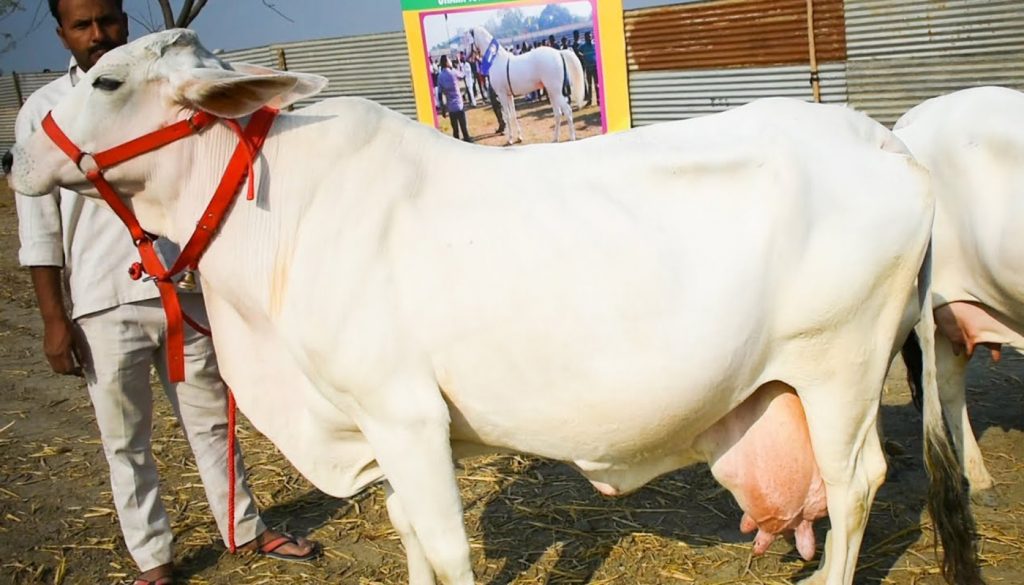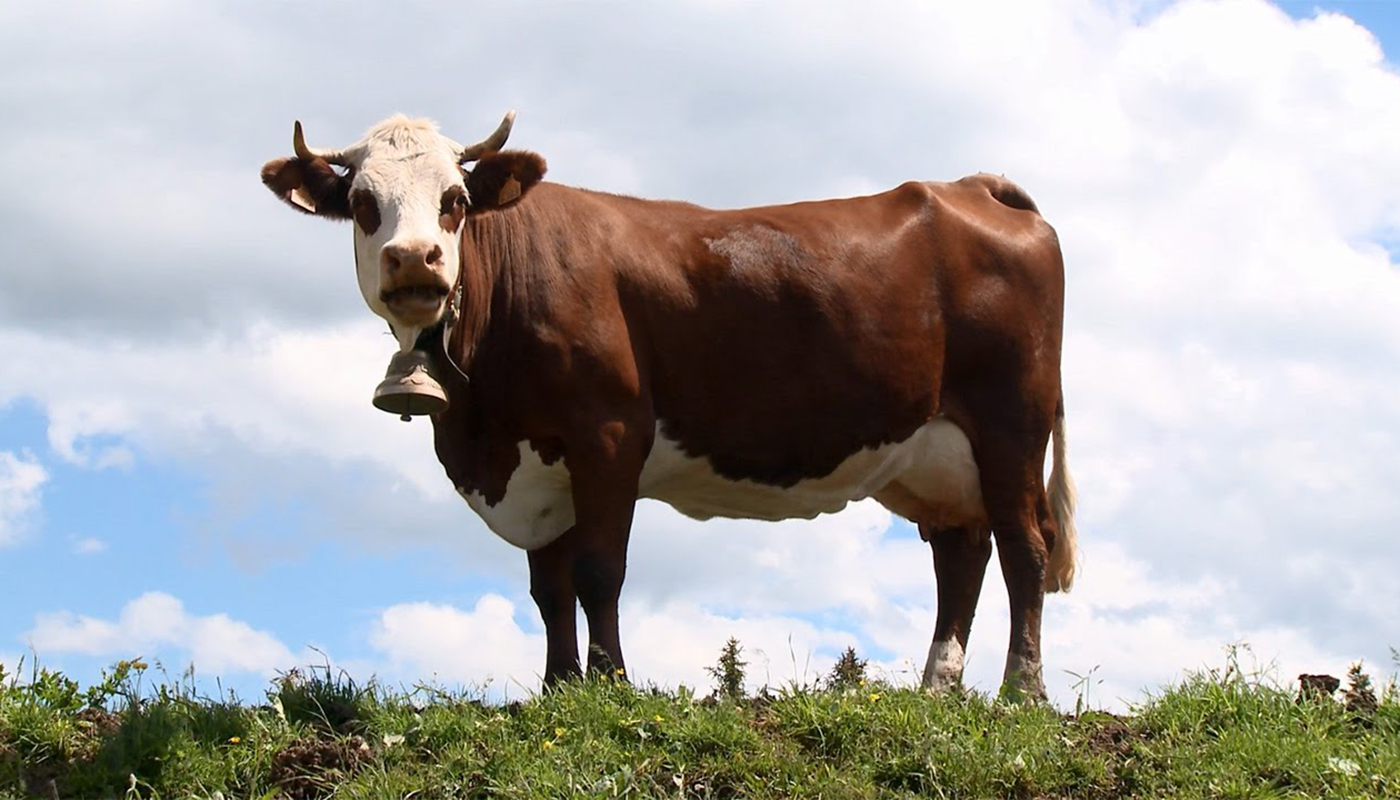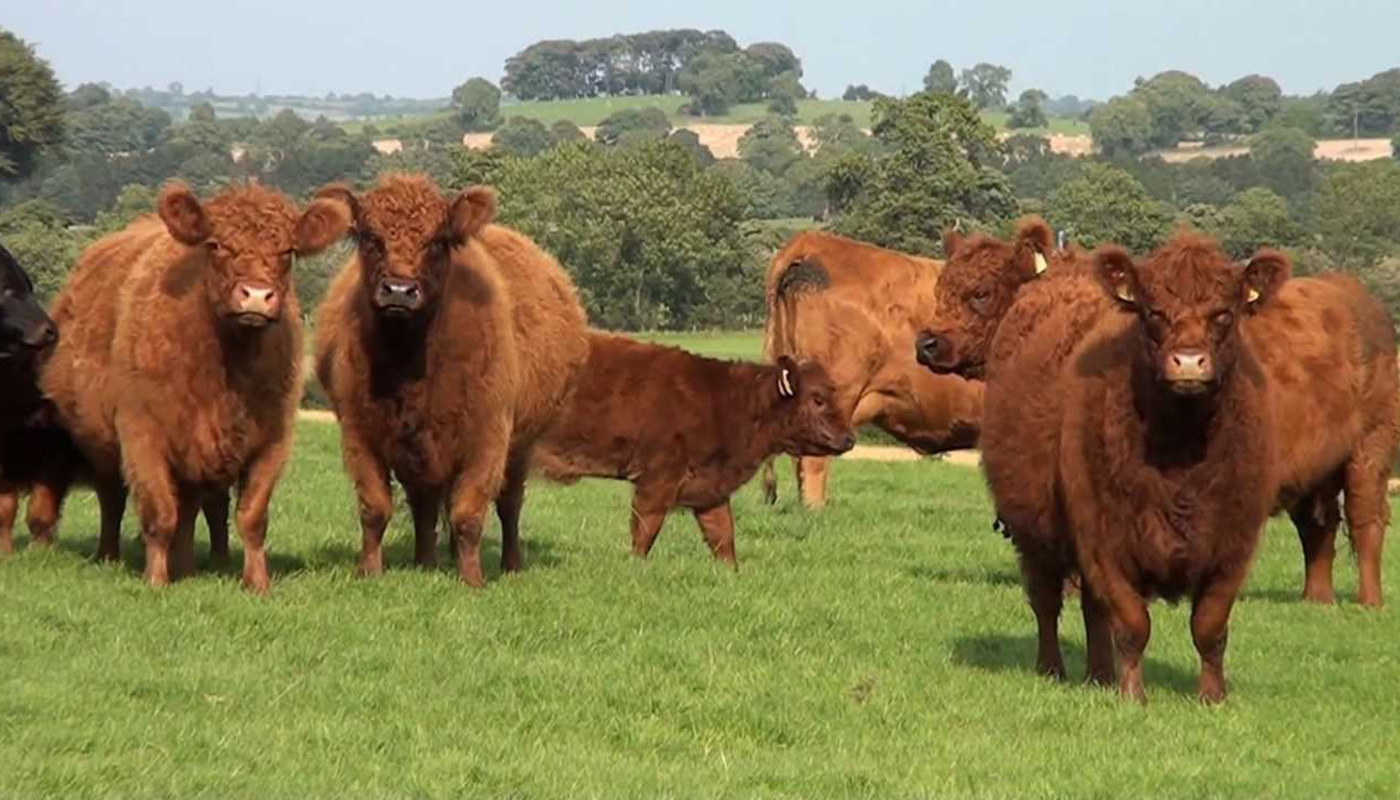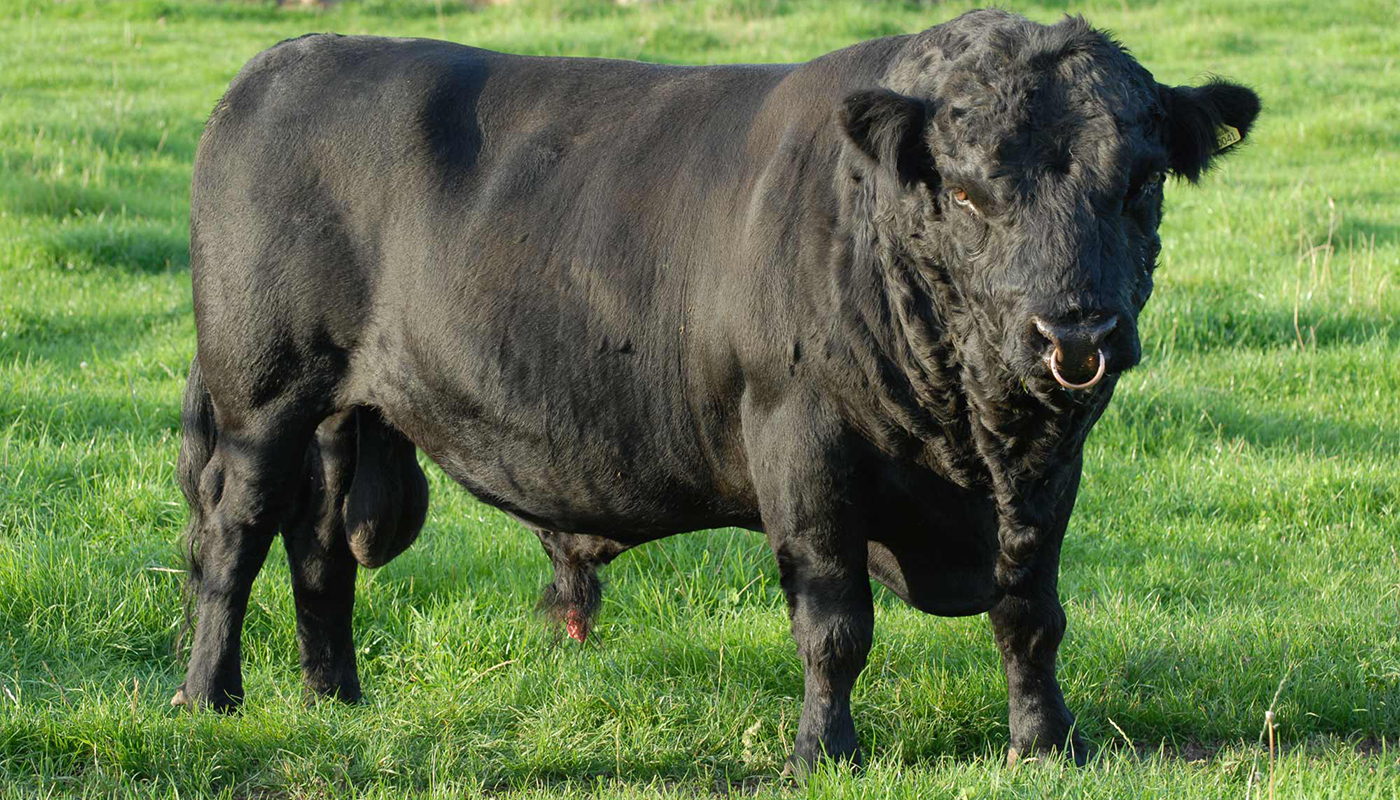
The Tharparkar breed of cattle is a medium-sized breed with a beautiful silvery white coat. They are good for milk production but need attention to ensure that they do not turn shy or wild. They have bits of gray on them that is said to change with the season or age of the cattle or if a cattle is pregnant.
THARPARKAR CATTLE BREED OF CATTLE QUICK PROFILE OVERVIEW
|
|
|---|---|
| The Tharaparkar cattle breed are a dairy breed of cattle that come from the Tharaparkar district in Sindh province of present-day Pakistan. | |
| Country of Origin: | Pakistan |
| Other Names: | White Sindi, Cutchi or Thari |
| Main Purpose: | Milk |
| Can be used for | Breed, Milk |
| You may Also Like: | 35 Best Cattle Breeds for Milk – Dairy Cattle |
| You may Also Like: | 47 Best Cattle Breeds for Meat – Beef Cattle |
| Ideal Climate: | Heat, Cold, Most Climates |
| Conservation Status: |
Not Listed by the *ALC Status/Rarity: Not at risk |
| Health Issues? | No known health issues |
| Good Starter Cattle? | Novice to intermediate Cattle farmer/keeper level |
| Cattle Associations: | Unclear – Please check with the American Dairy Association, National Association of Animal Breeders, Beef Cattle Breed Associations or The Beef Industry’s Information Center |
| Cattle Clubs: | Unclear – Please check with the American Dairy Association, National Association of Animal Breeders, Beef Cattle Breed Associations or The Beef Industry’s Information Center |
| Where to buy them? | Unclear – Please check with the American Dairy Association, National Association of Animal Breeders, Beef Cattle Breed Associations or The Beef Industry’s Information Center |
| Child Friendly? | Livestock should not be left unattended around unsupervised children |
| General Information: |
The Tharaparkar cattle breed are cattle from the lyre horned zebu type cattle. This means that that will have a hump on their back usually between their neck and shoulder blades. They usually have a loose dewlap and lyre shaped long horns.
They are hardy cattle that can withstand most environments, climates and feeding conditions. Efficiently turning low-product feed into a good source of milk with a healthy butterfat to protein ratio. But not much interest has been taken in the breeds meat. |
| Note: *ALC stands for American Livestock Conservancy | |
PHYSICAL CHARACTERISTICS |
||||||||||||||||||||||||||||||||
|---|---|---|---|---|---|---|---|---|---|---|---|---|---|---|---|---|---|---|---|---|---|---|---|---|---|---|---|---|---|---|---|---|
| The Tharaparkar cattle breed are a medium sized breed with a beautiful white to silver-grey hide. They are of the Zebu type cattle and as such both the male and female have a hump between their shoulders and a loose dewlap. The males hump tends to be bigger and more pronounced than that of the females and is often a darker grey to black color. They have long rectangular faces with a slightly upturned snout and long loped ears. They have a blockish well-defined body and long powerful legs. | ||||||||||||||||||||||||||||||||
| Size: | Medium | |||||||||||||||||||||||||||||||
|
||||||||||||||||||||||||||||||||
COW BREEDING & MILKING INFORMATION |
|
|---|---|
| Most Cattle produce milk but not all of them are used in the dairy Cattle capacity for their milk. Cows only calve once a year and should have 12 to 14-month inter-calving cycle. They are excellent mothers and produce quite a large amount of nutritious milk that they can efficiently produce on low quality feed. They have great motherly instincts, good birthing rates that are easy with little to no birthing problems. | |
| Breeding Period/cycle: | Usually lasts 6 to 24 hours Most ave. 12 to 16 hours Cows usually come on heat every 21 days. |
| Estrous cycle: | Ave. 17 days to 24 days Heifer – usually ave. 20 days Cows – usually ave. 21 days |
| Gestation Period: | Usually, around 279 to 287 days but most gestation is 283 days. Cows that are carrying bull calf’s their gestation period is usually a little longer than cows that are carrying heifer calves. |
| No. Calves/Litter: | 1 calf at a time. Cows rarely have twins or triplets, but it can happen |
| Lactation Period: | Cows lactation period can last for up to about 10 months (305) days. |
| Milking From: | 1 to 6 weeks after Calving |
| Drying off Period: | The cow should have a 12 to 14-month inter-calving cycle. Drying off period for around 60 days before she can calve again. |
| Milk Quality: |
Good, Butterfat = 5%, Protein = 4% Quantity: 3000 – 3500 kgs Per: Lactation period |
| Milk Ideal for: | Calves, drinking, cheese, and other dairy products |
| You may Also Like: | 35 Best Cattle Breeds for Milk – Dairy Cattle |
CATTLE MEAT PRODUCTION INFORMATION |
||||||||
|---|---|---|---|---|---|---|---|---|
| The Tharaparkar cattle and not bred for their meat they are used as a dairy cattle breed. | ||||||||
| Meat Production? | N/A | |||||||
|
||||||||
| You may Also Like: | 47 Best Cattle Breeds for Meat – Beef Cattle | |||||||
CATTLE SKIN PRODUCTION INFORMATION |
||||||||
|---|---|---|---|---|---|---|---|---|
| Most meat Cattle will have a skin by-product, and these are usually used in some form or just as a hide. They Tharaparkar cattle are not used for their meat. | ||||||||
| Skin Production? | N/A | |||||||
| Skin is used to Produce: | Calf/cow skin leather products such as shoes, car seats, fine leather coats, gloves, handbags, belts, furniture, rugs, etc. | |||||||
|
||||||||
HISTORY
As with a lot of cattle breeds, there is not much known about the breed but where they originated from and that they first became prominent in the First World War. Some of the cattle were taken in order to supply milk to Near East army camps.
It was in these camps that the cattle breed caught people attention. Under rigors and unsavory conditions, the animals still managed to produce a more than adequate amount of good quality milk. When left on arid pastures the cow will still produce in excess of 1135 kgs of milk per lactation. In well maintained villages the cow can produce on average around 1980 kgs of milk.
They are known as Tharaparka cattle as they come to the Tharaparkar district in the Province of Sind. Here they are known as a different name to Tharaparkar it is known here as Thari after the desert Thar.
They are usually kept in small to large herds ranging from around 30 head of cattle up to 300 heads of cattle. They are kept by Maldars who are professional cattle breeders.
Video
USEFUL LINKS
- Purebred Dairy Cattle Association
- American Dairy Association
- National Association of Animal Breeders
- American Dairy Science Association
- United States Cattlemen’s Association
- National Cattlemen’s Beef Association
- American National Cattlewomen
- Beef Cattle Breed Associations
- National Cattlemen’s Beef Association
- Fur Commission USA
- North American Meat Institute
- American Livestock Conservancy
- Animal Shelter (ASPCA)
- American Veterinary Medical Association
- American Animal Welfare Society
- American Animal Control
- American Society of Animal Science
- United States Department of Agriculture
 Abondance Cattle Breed – Everything You Need to Know
Abondance Cattle Breed – Everything You Need to Know Kankrej Cattle Breed – Everything You Need to Know
Kankrej Cattle Breed – Everything You Need to Know Boran Cattle Breed – Everything You Need to Know
Boran Cattle Breed – Everything You Need to Know Simmental Cattle Breed – Everything You Need to Know
Simmental Cattle Breed – Everything You Need to Know Parthenaise Cattle Breed – Everything You Need to Know
Parthenaise Cattle Breed – Everything You Need to Know Galloway Cattle Breed – Everything You Need to Know
Galloway Cattle Breed – Everything You Need to Know Blonde d’Aquitaine Cattle Breed – Everything You Need to Know
Blonde d’Aquitaine Cattle Breed – Everything You Need to Know Black Hereford Cattle Breed – Everything You Need to Know
Black Hereford Cattle Breed – Everything You Need to Know Beefalo Cattle Breed – Everything You Need to Know
Beefalo Cattle Breed – Everything You Need to Know Dexter Cattle Breed – Everything You Need to Know
Dexter Cattle Breed – Everything You Need to Know Dutch Belted Cattle Breed – Everything You Need to Know
Dutch Belted Cattle Breed – Everything You Need to Know Santa Gertrudis Cattle Breed – Everything You Need to Know
Santa Gertrudis Cattle Breed – Everything You Need to Know